#harmon ising
Explore tagged Tumblr posts
Text
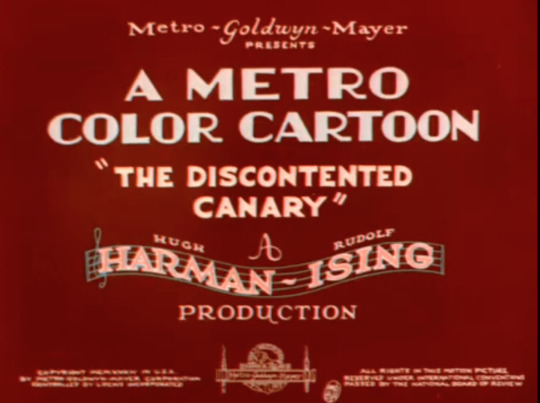

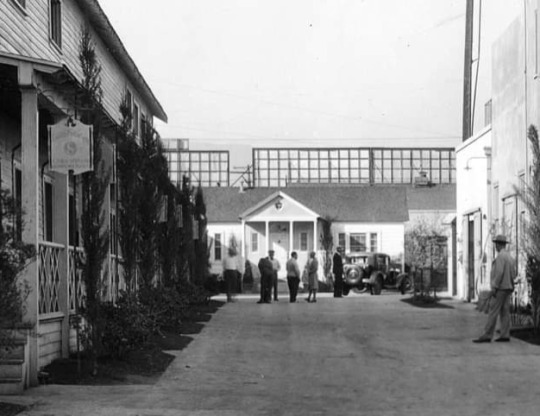
The Harmon - Ising Cartoon Studio was located on Melrose Avenue in the complex now known as Raleigh Studios.
13 notes
·
View notes
Text
BECOMING OF THE BEING :
When love falls in love with itself, it knows no gender, it knows no religion, it knows no geography, it knows no caste, it knows no creed, it knows no societal bindings, it knows no limitations. It is sheer love and infinite. That state is called the subtle in harmony with the gross. One does not have to struggle then. Life flows. Desireless and selflessly love loves love and becomes being. Then whatever one touches, it becomes GOLD. So what is the structure of this POTENTIAL rising as TRINITY that creates the gross? and how can we return back to this subtle so that the ISNESS becomes the BEING? Trinity is the interlacing of COGNITION, ACTION AND DESIRE into a summation that is PURPOSEFUL (desire less / selfless) since the LOVE IS IN LOVE with LOVE through our BEING or through FORM of the MANIFEST. Such love creates, sustains endures and breeds peace harmony abundance happiness and a CLASSY LIFE full of TRANQUILITY . Tranquility comes to those into whose mind all desires enter as streams enter the immovable ocean of waters, not to him who anxiously courts desires. Such strength comes when one becomes love from the core of its being - the core is the tetrahedron center right in the living space and aligned with the being space and fed from the subtleness center complete harmony with the essence.
Examples of such perfect alignments are city of Prague, The Structure of Pyramid, The Human Temple in Luxor and the Painting Called Monalisa. The unbounded subtle becoming the bounded being but in complete harmony as depicted in the da vinci painting called Vitruvian man . Mozart's music is another example of the subtle traits of art, music, dance, architecture and human form playing the cosmic dance of the light, sound and vibration ( time ) manifesting as a complete and perfect harmonic of the subtle.
As in Micro, so in Macro. The whole exists within the minutest particle and the minutest particle contains the whole. The atom contains the universe and the universe contains the atom, and neither exists without the other. Creator exists within creation, even as creation exists within creator. As Above, So Below. As Below, So Above. To accomplish the wonders of the One only thing . When inner space and outer space resonate together in harmony then peacefulness, vitality, health, prosperity, and dynamic, ecstatic creativity become the natural order and effortless experience.”
Achieving peace is a global as well as local problem, and that, global civilization, at its very core, believes and accepts that Nature's design is based on scarcity -- despite the scientific evidence manifesting this century, instructing us that, in fact, sufficiency, or plenitude, is the "normal" condition in Universe, and by extension, on earth.
Nations, and societies, built on a belief in scarcity, are ancient in their origins, and dominate, globally and locally, the way life is conducted at every level. Competition is the dominate strategy employed to secure and insure both short term and on-going survival in a presumed (wrongly) resource-scarce (not enough-for-all) environment.
A meshing and integration in optimally potent ways, of our new understandings of plenitude with the globally dominant and omni-present, scarcity based and driven, economic and political systems is critical, if there is ever to be a truly enduring and self-sustaining global peace.
Accruing proofs of, and ready access to, plenitude and sufficiency, have potentially profound and ameliorative effects on the quality of life for virtually the whole of humanity. Along with the new understandings, there needs to be created new ways of organizing and conducting our affairs and efforts--so that sufficiency-for-all becomes the new operational reality.
HOW CAN THE BASIC TETRAHEDRON GEOMETRY OF THE UNIVERSE BE DEPLOYED TO BRING ABOUT THIS CHANGE AT INDIVIDUAL AND GLOBAL LEVEL .
As you may be aware, we are fresh and new every moment.
Every year - About 98% of the atoms in your body are replaced. Every 6 months - Each of your finger and toenail grows from base to tip. Every 120 days - Your RBCs are completely replenished. (The average age of red blood cells is 120 days.) Every 28 days - Your skin renews itself. Every 14 days - Your stomach produces a new layer of mucus or it would digest itself. Every 10 days - The average life of your taste buds. Every 48 hours - Any loss of blood (even due to blood donation) is replenished. Every 24 hours - Your blood travels 60,000 miles on its journey through the body. Every 24 hours - A man’s testicles manufacture 10 million new sperm cells – enough that he could repopulate the entire planet in only 6 months! Every 30 minutes - Your body gives off enough heat (combined) to bring a half gallon of water to boil. Every minute - Your single blood cell makes a complete circuit of the body. Every minute - You take about 15 breaths and replenish the oxygen in your body Every second - 15 million blood cells are destroyed in your body.
Let us remember,
1. We are never the same between any two moments and the new moment does not come once in a year. As a wise man said, you can't step into the same river twice. 2. It takes the interaction of 72 different muscles to produce human speech. Hence let us take care of every word we utter. Let us be kind and pleasant in every of our utterances. 3. Our eyes are always the same size from birth, but our ears never stop growing. Hence let us listen more and more and more. 4. With every thought we have an option to be a new and fresh. Here nature does not give us a choice. 5. We are what we eat and hence exercise kindness and mercy. Try to be a vegetarian.
May this journey in evolution of awareness start from today. May we realize that this awareness/consciousness is the almighty.
I wish you to be aware of every moment as a new moment, every breath you take to breathe a fresh lease of life into you, and every thought results in peace, prosperity, health and happiness.
May 2024 help us all to progressively evolve into this journey of awareness. May this be the start of "The becoming of a being".

2 notes
·
View notes
Text
Knowing Shintoism

Shintoism is a traditional religion originated in Japan that has influenced the Japanese people’s view of the world. It is rooted in Japanese culture. Shinto means “the way of the gods” or “the way of the divine”. This is based on a belief system that everything existing in this world, whether living or not, has a spirit or also known as kami that is deserving of worship and respect. Kami can be from anything like mountains or rivers.
ITS ORIGIN
Shintoism is believed to be a religion with no founder. However, it arose with unification of Japanese people back on the 6th century BC. Shinto was created for the native religion to distinguish it from the Chinese religion and philosophy, Confucianism and Budhism. Buddhism overshadowed Shintoism as the gods were considered as manifestations of Buddha. Originally, Shinto shrines were taken care of by Buddhist priests, who mixed Buddhist rituals with Shinto practices.
In the 9th century, a new religion called Ryobu Shinto, which means the Shinto of two kinds), combined elements of Shinto, Buddhism, and Confucianism. This was established by Kukai or Kobo Daishi, with Buddhism denominating Shinto and adapting the elements of Confucianism. This is the time where Shinto became less prominent. Emperors themselves had become Buddhists and Shinto-priests became fortune-tellers and magicians.
In the 18th century, Shinto was revived as a nationalistic religion, emphasizing the emperor's divine right to rule and Japan's superiority. This is through the writings and teachings of a succession of notable scholars, including Mabuchi, Motoori Norinaga, and Hirata Atsutane. This ideology fueled Japanese military expansion before WWII.
Beliefs
The followers of Shintoism mostly believe in spiritual powers. They also believe that there are spirits living inside natural living things or places. One of the concepts they believe in is comparable to yin and yang, where everything has its opposites. These things, as they say, are meant to balance and live in harmony. Examples of these are the sun and moon, fire and water, and the world and netherworld.
Gods

At the heart of Japanese mythology lies the story of the sun goddess Amaterasu Omikami. Amaterasu, the most revered, is considered the ancestor of the Japanese emperors. Amaterasu, also known as Amaterasu Omikami, is a superstar in Japanese mythology. Her name translates to "The Great Divinity Illuminating Heaven" – basically, the sun goddess who rules the heaven she's also known as Ohirume no Muchi no Kami, which means "The Great Sun of the Kami".

Alongside other divine spirits (kami), creation myths tell of Izanagi and Izanami birthing the Japanese islands and ancestral kami.
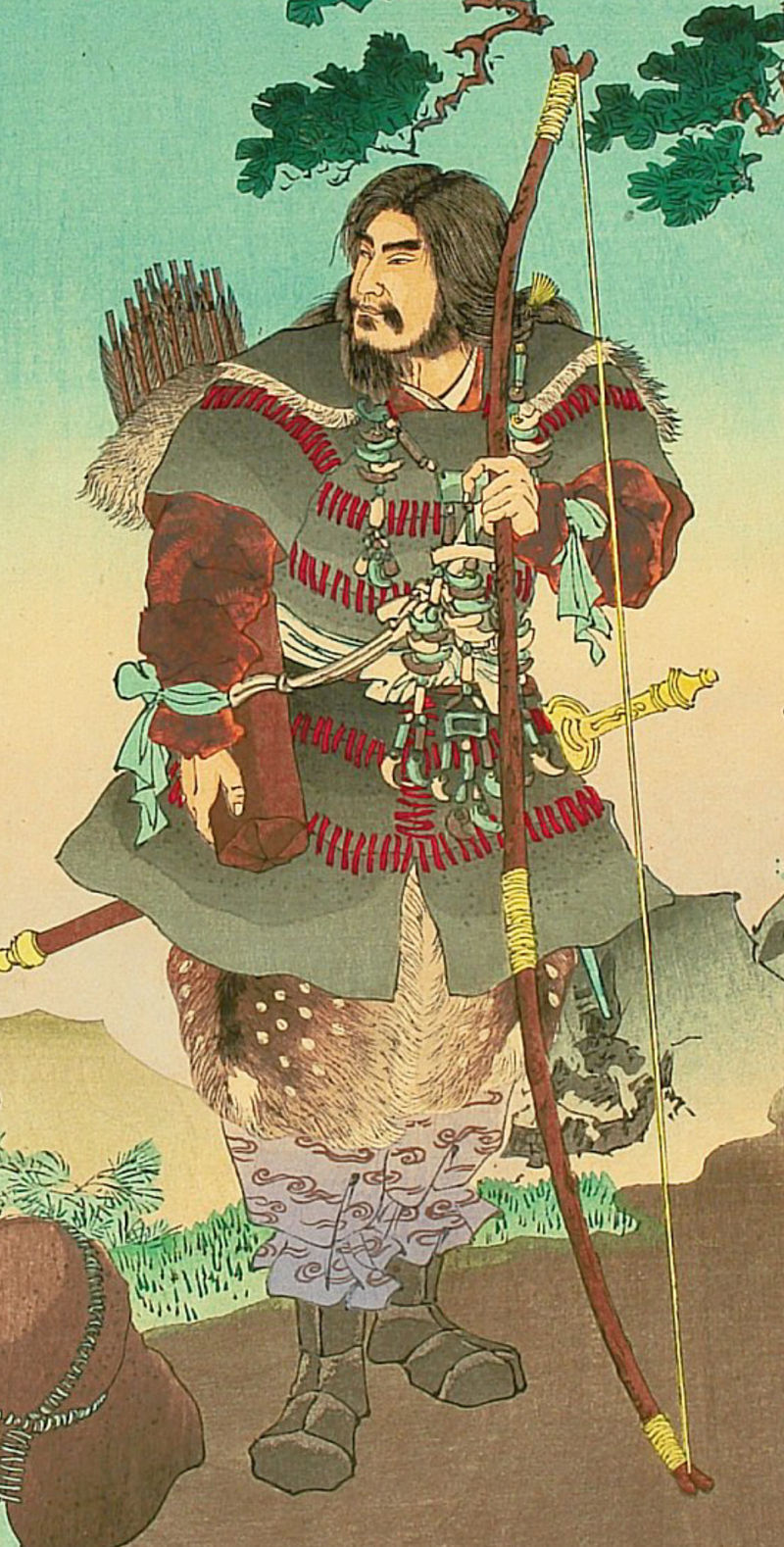
Legends recount her descendants, like Jimmu, the supposed first emperor, unifying the people.
This divine lineage is further emphasized by the Three Sacred Treasures – a mirror, sword, and jewels – passed down from Amaterasu, symbolizing the emperors' divinely ordained rule.Even today, the Inner Shrine of Ise-jingu, dedicated to Amaterasu, stands as a testament to her enduring legacy in Japanese mythology and Shinto religion.
DOCTRINES
At the heart of Shintoism lies a profound reverence for kami, the mysterious and harmonizing spirits believed to inhabit all aspects of existence. Central to Shinto belief are concepts such as musubi, the creative force of kami, and makoto, the truthful will of these divine beings. Though the nature of kami transcends human understanding, devoted followers apprehend them through faith and recognize their polytheistic manifestations. Each shrine's parishioners regard their tutelary kami as the source of life and existence, believing in their divine personalities and the power of truthful prayers to evoke responses from them. In traditional Japanese thought, truth is embodied in empirical existence and is constantly transforming. Makoto, the truthful way of kami, is discerned through every moment and encounter with these divine entities. Shinto teaches that living in accordance with a kami's will not only garners their protection and approval but also fosters a mystical power that gains the cooperation and support of all kami. However, there are some key principles and beliefs that are commonly associated with Shintoism:
Kami: Shintoism revolves around the concept of kami, which are sacred spirits or divine beings that inhabit natural elements, objects, and phenomena. These can include deities, spirits of ancestors, and even spirits of natural features like mountains, rivers, and trees.
Harmony with Nature: Shintoism emphasizes a deep reverence for nature. Nature is seen as inherently sacred, and humans are encouraged to live in harmony with it, respecting and appreciating its beauty and power.
TRADITIONS
Visiting Shrines (Omairi) Shinto shrines (Jinji) are public places constructed to house kami. Anyone is welcome to visit public shrines, though there are certain practices that should be observed by all visitors, including quiet reverence and purification by water before entering the shrine itself. Worship of kami can also be done at small shrines in private homes (kamidana) or sacred, natural spaces (mori).

Purification (harae or harai) It is a ritual performed to rid a person or an object of impurity (kegare). Purification rituals can take many forms, including a prayer from a priest, cleansing by water or salt, or even a mass purification of a large group of people
Kagura (Ritual Dances) Kagura is a type of dance used to pacify and energize kami, particularly those of recently deceased people. It also is directly related to Japan’s origin story, when kami danced for Amaterasu, the kami of the sun, to coax her out of hiding to restore light to the universe. Like much else in Shinto, the types of dances vary from community to community.
FESTIVALS
Matsuri A matsuri is a traditional festival that honors the Japanese gods with processions, dances, performances, and parades. Usually accompanied by yatai, games, and beverages, this religious celebration takes a very colorful turn. In Japan, matsuri are held throughout the year.

Spring Festival (Haru Matsuri, or Toshigoi-no-Matsuri; Prayer for Good Harvest Festival) Springtime (January to May) is a period for haru matsuri, or festivals, many of which revolve around the sowing of crops. Around the nation, various shrines celebrate on different days. This springtime ceremony provides an opportunity to thank the gods for a bountiful harvest.
Autumn Festival (Aki Matsuri, or Niiname-sai; Harvest Festival) During the late summer and early fall, there are several aki matsuri, or autumn celebrations, where people praise the kami for a bountiful crop. Around the nation, various shrines celebrate on different days. The Imperial family performed rites at the festival's initial harvest celebration to express gratitude for a bountiful crop production
Annual Festival (Rei-sai) This is an annual celebration that falls on a certain day that is significant to the shrine hosting it. During this celebration, the local kami are paraded through the town or village in effigy while riding on an elaborate litter known as a mikoshi, which resembles a sedan chair. There are frequently musicians and dancers accompanying the procession, and the event is joyous overall. Within the shrine, more solemn rites are held.

Divine Procession (Shinkō-sai)
A mikoshi, or "divine palanquin," is frequently seen in the processions carrying a kami or an image of a kami. A common description of the mikoshi is that of a transportable altar or shrine.
The local community that is devoted to the kami of the shrine is visited by them during the mikoshi parade, which is believed to bestow a blessing onto them.
Since Shinto's roots lie in Japan's agricultural antiquity, the majority of its festivals coincide with the agricultural seasons
3 SECTS OF SHINTOISM
Shrine Shinto, is the oldest way of practicing Shinto, is like visiting special buildings called shrines to honor spirits of nature and ancestors (kami) with gifts and ceremonies. It's been around for a very long time and is connected to Japan's royal family. This type of Shinto puts a lot of importance on living in balance with nature. This sect is also called Jinja Shinto.
Sect Shinto, also known as Shuha Shinto, is a bunch of newer Shinto groups that started in the 1800s. Unlike Shrine Shinto, these groups often have a clear leader, specific beliefs, and organized structures. After World War II, even more groups popped up, with some wanting to bring back old practices, some mixing Shinto with other religions, and others focusing on healing through faith.
Folk Shinto, or Minzoku Shinto, is all about honoring kami in your daily life, especially in rural areas. People show respect to small statues on roadsides and perform rituals during different parts of the farming year to bring good harvests and keep their families safe. These traditions are often passed down from parents to children and continue within communities.
1 note
·
View note
Text
Mariya Ise on Netflix Japan
So, Mariya Ise voiced Beth Harmon in Queen’s Gambit (both as a child and an adult). A brilliant casting choice.
Source: Japanese Wikipedia page 1 (TV show) + page 2 (actress) + Mariya Ise’s instagram

I’d love to rewatch Queen's Gambit with Japanese dub, but apparently there is no such option for me outside of, well, Japan. Having crossover thoughts. Killua Zoldyck and Beth Harmon - queens of fashion and killing stares.


21 notes
·
View notes
Note
man whenever I see popeye cartoons I'm astounded by how high quality the inking is. My biggest exposure to cartoons from that era was the old Harmon-Ising stuff in the looney tunes golden collections and the inking for those is a lot less slick there
YES!!! ink and paint is such a vital, KEY part to these cartoons that gets taken for granted a lot. Popeye has some wonderful inking, ESPECIALLY on close-ups like these—they’re hilarious enough as is, but the line weight really sells them and makes them all the funnier
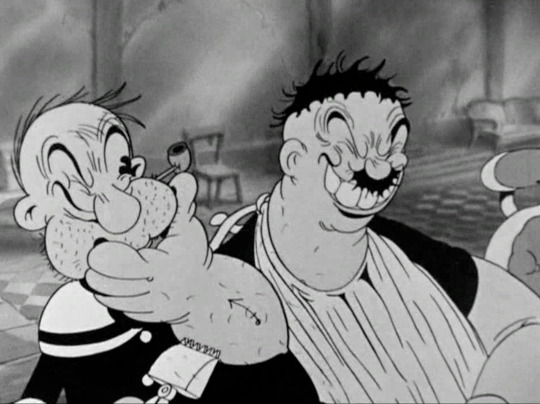
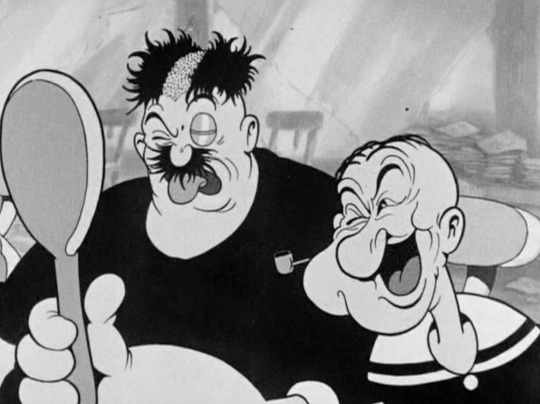
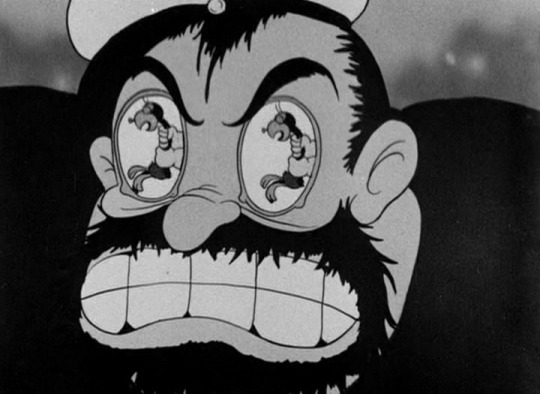
and YEAH, poor inking can do a lot to ruin a scene, even if the animation itself is fine. the beginning of Bugs Bunny and the Three Bears really suffers from poor inking:
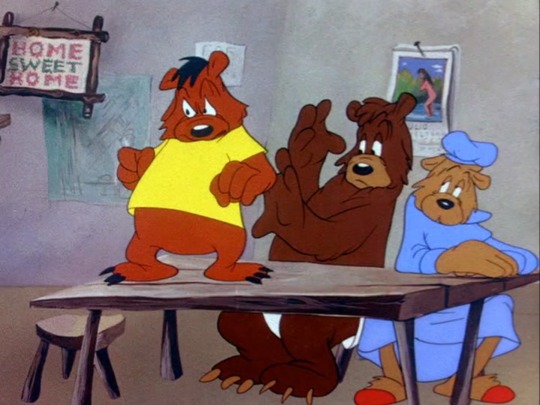
Bobe Cannon’s animation is fine itself, but the clean-up work and inking is pretty poor and so the animation unfortunately appears really floaty and weightless and unappealing, which is a shame. solid, confident lines can REALLY be transformative and it’s something i’ve learned a lot while working in the animation industry.
but in any case YES, Popeye cartoons are one of life’s greatest joys and i’m only 10% facetious here. really really REALLY encourage people to check them out if you haven’t already, they fill me with so much unadulterated joy and i absolutely adore them. i’m with you in that a lot of my knowledge of ‘30s animation was just LT cartoons from the same era like oh, 1936? i’ve seen LT cartoons from then! those were fun. but Popeye blows EVERYTHING out of the water. it’s amazing just how much these guys were accomplishing so early on and so WELL. they really do change your perception in the best ways possible. i love love love LOVE me some Popeye, it’s just wholly enjoyable and really gets me going about why i’m so passionate for cartooning
58 notes
·
View notes
Photo
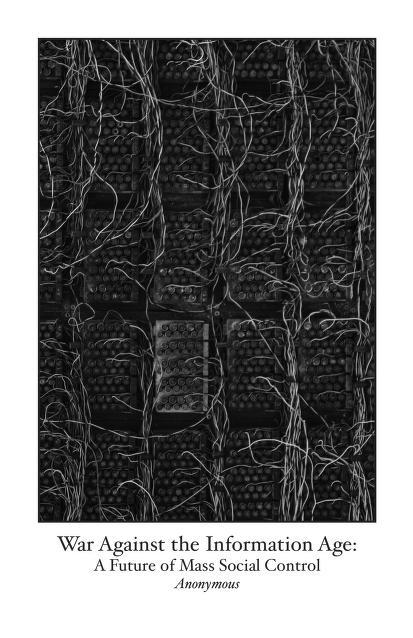
https://archive.org/details/counterflow_2021_war/counterflow_2021_war/mode/2up
‘’As capitalist imperialism consolidates its economic borders through an ongoing paramilitarisation process and harmon- ised internal policing structure to cope with increased external war and social-ecological collapse, there is an amplification of repression in response to the manufactured ‘crisis’ of the bank ers. Enough decentralisation in the hegemony is maintained to allow internal security services to retain sufficient self-rule to operate according to the local situations, but generally speak- ing , the areas of amplification — ‘terrorism’ and immigration (specifically mass incarceration and deportation) — correspond with a rise in an encouraged nationalism and the prison-society.’’
3 notes
·
View notes
Text
Melekler ༄
Melekler, gerçek hayattaki ölümlerinden sonra Seovana’daki isyancı grubu durdurmakla görevli kişlerdir.
➵ Üç tane melek vardır ve bu melekleri ana hesap atılan başvurulara göre seçecektir.
➵ Melek seçildiğiniz zaman yine de başvuruda seçtiğiniz isyancı grup klanına, başvuruyu attığınız hesapla girmek zorundasınız. Normal günlerde o hesap ile gönderi paylaşarak aktifsizlik sınırınızı aşmamalısınız, ayrıca arada sohbet gruplarında da konuşmalısınız. Kaos günleri ise melek hesabına geçerek size verilecek talimatları beklemelisiniz. Bunun haricinde melek hesabınızda diğer meleklerin de bulunduğu bir hesap açılacaktır. Bu grupta Seovana’ya indiğinizde yapacaklarınızı konuşabilirsiniz.
➵ Melekler kolay ölmezler ve öldürmek için iyi bir plan yapılmalıdır. Eğer planınızı iyi kurar ve meleği köşeye sıkıştırırsanız onu öldürme hakkına sahip olursunuz. Onun dışında baştan savma bir kurguyla meleği öldüremezsiniz.
➵ Her 3 meleğin başta bir tane gücü(Hand Sonic) olacaktır. Elde ettiği başarıya göre diğer güçleri almaya hak kazanacaktır.
➵ Ölen karakter, melek hesabını etkilemeyecektir ve meleği oynatan yeni oyuncu aynı güçle devam edecektir.
➵ Her kaosta isteğinize bağlı bir isyancı grup üyesini öldürebilirsiniz, bu yeni güçler kazanmanızda etkili olacaktır. Ayrıca ölen oyuncu yeni kurgu ile tekrar oyuna girebilir.
BECERİLERİ :
Hand Sonic : Her iki elinden de birer bıçak çıkarır. Bu bıçaklar mermileri ve üstüne gelen cisimleri kesebilir. Oyunun başlangıcında melekler sadece bu özelliğe sahip olacaktır.

Distortion : Önünde görünmez bir kalkan oluşturarak mermileri fırlatıp atmasını sağlar. Bu yeteneğin sakıncası, savunmadan hücum durumuna geçmek isterse onu ortadan kaldırması gerektiğidir.

Delay : Yakın mesafeden bir çeşit görüntü oluşturur. Düşmanı başka yerlere saldırması için kandırarak yakın dövüş saldırılarından kaçınmakta etkilidir.

Angel Wings : Kanatlarını arkadan filizler, bu kanatları uçmanın yanında iniş yaparken de kullanır. Ayrıca bir binanın çatısından atlamak gibi uzun yükseksiklerde hayatta kalmasını sağlar.

Harmonic : Kan kırmızısı gözleri dışında, kendisi ile aynı olan bir klon yapar. Bu kabiliyet aracılığıyla yaratılan klonlar, Harmonic'lerin kendisi de dahil olmak üzere orijinalin tüm yeteneklerinin yanı sıra kendi bilincine sahiptir . Kopya, yaratılış anında hissettiği şeyin formlarıdır. Bu güce ulaşmak oldukça zordur.

2 notes
·
View notes
Text
Johannes Brahms, 2. Senfoni Op.73

19. yüzyıl sanatçısının sanata bakış açısını belirleyen temel parametrelerden biri tarihsel bilinç düşüncesidir. İki tezin bu dönemin sanatsal üretimlerini doğrudan şekillendirdiği görülür; birincisi, tüm bilginin tarih tarafından koşullandığı ve tarihten bağımsız bir hakikatin olamayacağı; ikincisi ise Hegel’in diyalektik felsefesidir.
Hegel insanlık tarihini “mutlak birlik” olarak nitelediği bir yaşamsal öze ulaşma süreci olarak tanımlar. Hegel’e göre tarihsel süreç, karşıtlıkların çatışması sonucu oluşan bir sentez, daha sonra tez haline gelerek karşısına çıkan yeni antitezlerle sürekli bir gelişim içerisinde ilerler.
Bu düşünceler, zamanın ruhunu kavramayı 19. yüzyıl sanatçısının temel meselelerinden biri haline getirmiştir. Şüphesiz, sanatçı zamanını kavrayabilmek için geçmişin ve onun çelişkilerinin bilincinde olmalıdır. Robert Schumann 28 Ekim 1853’te Neue Zeitschrift für Musik’te yayımlanan ve henüz 20 yaşındaki Brahms’ı göklere çıkardığı “Neue Bahnen” (Yeni Yollar) adlı makalesinde, sanatçının tam da bu hassasiyetini sergiler. Schumann, genç Brahms’ı okura “zamanı en yüksek ve ideal biçimde ifade etmeye yazgılı” bir besteci olarak tanıtır.

Ancak 19. yüzyılın ikinci yarısı geçmişin nasıl yorumlanacağına dair bestecilerin fikir birliğinde olduğu bir dönem değildir. Aksine, Avusturya-Alman müziği bu dönemde geçmişin değerlerini birbirinden çok farklı yorumlayan (ve günün müziğinin nasıl duyulması gerektiğine dair farklı tezler sunan) iki karşıt görüş öne sürmüştür. Bu polarizasyonun bir tarafında müziği edebiyatla birleştirmeye çalışan ve Haydn, Mozart ve Beethoven’ın klasisist yapısalcılığına karşı “süreklilik” anlayışını benimseyen “yenilikçi” Wagner ve Liszt, öbür tarafında da senfoni ve oda müziği gibi salt çalgısal müziğe (absolute music) bağlı kalarak müziğin soyutluğunu (dilsel bir anlama/anlatısallığa indirgenemeyeceğini) savunan “gelenekçi” Mendelssohn, Schumann ve Brahms yer alır.
Fakat Brahms’ın gelenekçiliği ile Mendelssohncu neo-klasisist yaklaşımın arasında temel farklılıkların olduğu vurgulanmalıdır. Mendelssohn, özellikle erken dönemlerinde yaptığı gibi, geçmişin klasik formlarını doğrudan müziğine uygularken, Brahms geçmişin müzik sistemlerini bir akademisyen titizliğiyle analiz edip, burada kendi döneminin müziğindeki çıkmazları çözmek için öngörüler aramıştır. Brahms için temel sorun, tematik kontrast prensibi üzerine kurulu sonat formunun müzikte süreklilik anlayışıyla nasıl bağdaştırılacağıdır. Brahms bu sorunu, tematik kontrast prensibi yerine sürekli dönüşüm ve varyasyon prensibini koyarak ve bunu kendine özgü armonik ve ritmik bir zenginlik ile birleştirerek çözmeye çalışmıştır.
Sanatçı kariyeri boyunca senfoni yazmak için oldukça temkinli davranmıştı. Kendi deyimi ile Beethoven gibi bir devin ayak izlerini arkasında hissederek bu işe kalkışmak çok zordu. Bu yüzden Brahms ilk senfonisini 14 yıllık bir çalışmanın ardından 43 yaşında bitirdi. 1876’da seslendirilen 1. Senfoni, besteciye büyük bir şöhret kazandırdı. Brahms bu başarıdan aldığı enerjiyle ikinci senfonisini hemen ertesi yılın yaz ve sonbahar mevsimlerinde bestelemiş, buradan daha da büyük bir başarı elde edip senfonist kimliğini iyice pekiştirmişti. Brahms, 1884’te son senfonisi olan 4. Senfonisi’ni bestelediği döneme geldiğinde, (Schumann’ın öngördüğü gibi) Alman müziğinin üç büyük B’sinden (Bach ve Beethoven ile birlikte) biri olarak anılmaktaydı.
2. Senfoni yukarıda anlatılan prensiple bestelenmiştir. Bu eser, hem birliği hem de çeşitliliği barındırır. Açık ve koyu, lirik ve kuvvetli, içe dönük ve dışadönük gibi karşıtlıklar başarıyla birleştirilmiştir. Tüm senfoni organik bir biçimde eseri başlatan ilk üç notanın (çello ve kontrbaslarda duyulan re-do-re diyez) oluşturduğu tohumdan büyür. Bu müzikal ekonomi kulağa içgüdüsel olarak açıktır ve ilgi veya spontanlıktan ödün vermeden eseri anlaşılır hale getirmeye yardımcı olur.
Birinci bölüm sözü edilen üç notalık hücre ve kornonun basit melodisi ile başlar. Bunu sırayla tanıştırılacak iki tema takip eder; birincisi kemanlar tarafından ilan edilir; ikincisi ise çello ve viyolaların gösterişli düetinde sunulur. Her iki temayı geliştirdikten sonra Brahms, ilk korno melodisini ve birinci temayı kısaca birleştirerek ilginç bir özetleme yaratır ve ardından da ikinci temayı yoğun bir şekilde ele alır.
İkinci bölüm, iki fagotun koyu bir kontrpuan ile renklendirdiği çelloların açılış temasıyla başlar. Brahms’ın içe dönük yanı en çok bu bölümde ortaya çıkar. Ancak yine de, bölümün hakim yavaşlığında şaşırtıcı bir ifade çeşitliliği kendini belli eder.
Üçüncü bölümde Brahms ilk kez yaylı çalgıların hakim olduğu dokuyu kırar ve pizzicato çello ve tahta nefesliler korosunun eşliğinde solo obuanın temasını duyurur. Çapraz ritimlerle dolu olan bu bölüm bir serenadın rahat karakterine sahiptir.
Karamsar ve öngörülemez ruhlu final, manik enerji ve huzursuzluk arasında salınır. Müzik bu bölümde neredeyse kontrolsüz bir biçimde ileri doğru parlar. 2. Senfoni ilk bakışta 1. Senfoni’nin karşıtı gibi görünür ve bu kontrast ilk seslendirmelerden itibaren Beethoven’ın 5. ve 6. (Pastoral) senfonilerinin arasındaki kontrasta benzetilmiştir. Gerçekten de Re majör tondaki ikincinin optimist ve dışadönük karakteri, Do minör tondaki birincinin karanlık ve fırtınalı ruhundan oldukça uzaktır. Bu eser anlaşılır bir biçimde bestecinin “Pastoral” senfonisi olarak kabul edilir ve dört senfonisi arasında en sevinçli olanıdır.
Johannes Brahms, Symphony No.2
Among the main parameters informing the artistic perspective of the 19th century artist is the idea of historical consciousness. Two theses are observed to directly shape the artistic productions of this period: the first of these is that all knowledge is conditioned by history, independent of which there cannot be any reality, and the other is Hegel’s dialectic philosophy. Hegel considers the history of humanity a process of moving towards an essence, which he describes as “absolute unity”. According to him, the historical process is a continuous development, in which a synthesis born out of the clash of opposites then form a thesis, which is then confronted by new antitheses.
With these ideas, understanding the spirit of time became one of the fundamental struggles of the 19th century artist. Understanding the spirit of time, undoubtedly required the artist to be aware of the past and its conflicts. This sensitivity is exactly what Robert Schumann displays in his article “Neue Bahnen” (New Paths), published on October 28 1853 in Neue Zeitschrift für Musik, where he praised Brahms, who was only 20, to the Skies. Schumann introduced the young Brahms to the readers as a composer “called to give expression to his times in ideal fashion”.
Still, the composers in the second half of the 19th century did not have a complete agreement on how to interpret the past. Quite the contrary, the Austrian-German music propounded two distinct ideas which interpreted the values of the past in very different ways (and which presented particular theses about how to hear the music of the time).
On one side of the polarization was the “innovative” Wagner and Liszt, who adopted an understanding of “continuity” as opposed to the classicist structuralism of Haydn, Mozart and Beethoven and who wanted to integrate music with literature, while the other side was held by the “traditional” Mendelssohn, Schumann and Brahms, who remained committed to pure instrumental music, like symphony and chamber music (absolute music), and defended the abstractness of music (which cannot be reduced to a lingual meaning/narration).
However, it should be noted that there are basic differences between Brahms’ traditionalism and Mendelssohnian neo-classicist approach. While Mendelssohn applied the classical forms of the past directly to his music, as he did particularly in his early period, Brahms analyzed the former music systems thoroughly like an academician and looked for foresights which could help him resolve the dilemmas in the music of his period. The main issue for Brahms was how to reconcile the sonata form based on the principle of thematic contrast with the understanding of continuity in music. Brahms strived to address this issue by replacing the principle of continuous transformation and variation with the principle of thematic contrast, and combining it with unique harmonic and rhythmical wealth.
Throughout his career, Brahms was very cautious about writing symphonies. As he put it, it was hard to make such an endeavor while following the footsteps of a prodigy like Beethoven. That is why Brahms could complete his first symphony at the age of 43, after 14 years of work. His first symphony performed in 1876 brought Brahms considerable success. With the vim and vigor of his success, he composed his second symphony in the summer and fall of the following year, and achieved even greater success, which helped him forge his identity as a symphonist. In 1884, as Brahms entered the period when he composed his fourth and last symphony, he had come to be recognized (as Schumann predicted) as one of the three great B’s of the German music (along with Bach and Beethoven).
Symphony No.2 was composed according to the principle outlined above. The work harbors both unity and variety. It successfully combines dark and light, lyrical and strong, internal and external contrasts. The entire symphony raises organically from the seed sown by the three notes with which the work starts (D – C – D sharp introduced by the cellos and double basses). This musical economy is instinctively convenient for the ear and helps make the work more understandable without sacrificing interest or spontaneity.
The first movement starts with the three-note cell mentioned above and the simple melody of the horn. This melody is followed by two themes presented in sequence; the first is announced by the violins and the second is presented through the pompous duet of cellos and violas. After developing both themes, Brahms briefly unites the introductory horn melody and the first theme to present an interesting summary, and then addresses the second theme thoroughly.
The second movement begins with the opening theme of the cellos, which is colored by a dark counterpoint of two bassoons. Brahms’ introverted side shows itself most clearly in this part, but still, an amazing variety of expression is evident in the dominant slowness of the movement.
In the third movement, Brahms disrupts the structure dominated by the strings for the first time, and presents the theme of the solo oboe in the accompaniment of the choir of pizzicato cellos and woodwinds. The movement full of crossing rhythms has the easygoing character of a serenade,
The finale with its pessimistic and unpredictable mood swings between manic energy and uneasiness. In this movement, the music shines forward almost uncontrollably. At first, the symphony appears to be in contrast to Symphony No.l and from the very first performances, this contrast was found similar to the one between Beethoven’s fifth and sixth (“Pastoral”) symphonies. In fact, the optimistic and extroverted character of the second symphony in D major is entirely different from the dark and stormy mood of the first one in C minor. Understandably, the work is acknowledged as the composer’s “pastoral” symphony and is the most joyous one among his four symphonies.
Aylin YILMAZ
7 notes
·
View notes
Text
Rick and Morty Yapımcılarından Heyecanlandıran Açıklama
Rick and Morty Yapımcılarından Heyecanlandıran Açıklama
2013’te yayınlanmaya başlayan yetişkinlere yönelik animasyon dizisi Rick and Morty, çıktığı günden beri büyük ilgi topluyor. Dan Harmon ve Justin Roiland tarafından Adult Swim için yaratılan yapımın altıncı sezonunun ilk fragmanı da geçtiğimiz haftalarda bizlerle buluşmuştu. 4 Eylül, yani önümüzdeki günlerde çıkış yapacak sezondan gelen bu video, hayranları bir hayli heyecanlandırmıştı. Şimdi ise…

View On WordPress
0 notes
Text
Olası satış baskısı için izlenecek seviyeler
Olası satış baskısı için izlenecek seviyeler
Bitcoin: BTC/USDT 44500 – 46000 direnç bölgesini kırarak 5. kez test edilen fiyat hareketi Harmonic CRAB Pattern oluşumunda. 50500 – 52000 direnç bölgesi olarak takip ettiğimiz hedef seviyesinde oluşan CRAB Formasyonu tamamlandıktan sonra satış baskısı gelebilir. Bu nedenle dikkatli olmakta fayda var. Satış gelir ise 46000 – 44500 ve 42400 destek seviyeleri takip edilmelidir. Bitcoin grafiği:…

View On WordPress
0 notes
Text
研究業績
Ecological Research( John Wiley & Sons, Inc. )に以下の論文が掲載されました。
Harmonized data on early stage litter decomposition using tea material across Japan
Satoshi N Suzuki, Mioko Ataka, Ika Djukic, Tsutomu Enoki, Karibu Fukuzawa, Mitsuru Hirota, Takuo Hishi, Tsutom Hiura, Kazuhiko Hoshizaki, Hideyuki Ida, Akira Iguchi, Yasuo Iimura, Takeshi Ise, Tanaka Kenta, Yoshifumi Kina, Hajime Kobayashi, Yuji Kominami, Hiroko Kurokawa, Kobayashi Makoto, Michinari Matsushita, Rie Miyata, Hiroyuki Muraoka, Tatsuro Nakaji, Masahiro Nakamura, Shigeru Niwa, Nam J Noh, Takanori Sato, Tatsuyuki Seino, Hideaki Shibata, Ryo O Suzuki, Koichi Takahashi, Tomonori Tsunoda, Tasuhiro Ustumi, Kenta Watanabe
以下で概要を閲覧できます。
https://db.cger.nies.go.jp/JaLTER/ER_DataPapers/archives/2019/ERDP-2019-04/metadata
0 notes
Text







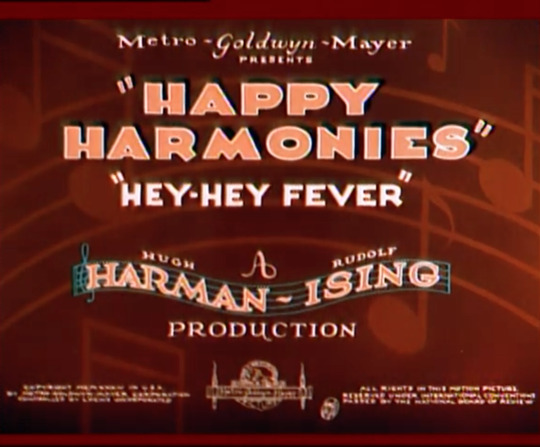


The Harmon-Ising animation studio in the new Cecil B. DeMille Building at 5663 Hollywood Boulevard.
#art deco#east hollywood#architecture#harmon ising#cartoon#cartoons#hollywood studios#cecil b. demille
19 notes
·
View notes
Text
184. the woods are full of cuckoos (1937)
release date: december 4th, 1937
series: merrie melodies
director: frank tashlin
starring: mel blanc (owlcott, walter finchell, milton squirrel, wendell howl, fox, raven mcquandry), tedd pierce (ben birdie, tizzie fish, andy bovine), sara berner (polly gillette, canary livingstone)
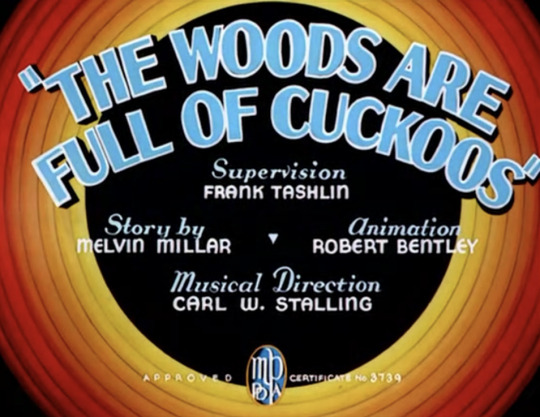
this cartoon gets the honorable award of possibly being the most dated warner bros. shorts in its vast repertoire of cartoons. not to worry! this will be a fun cartoon to unpack—i love delving into the shorts that involve extensive research. learning something new is something that‘s very rewarding to me, and i hope it is to you, too!
a giant ode to the short lived radio program community sing (lasting from 1936-1937), the short chronicles a woodland radio show hosted by a variety of caricatured animals putting on various acts.

iris in to the ringing of a bell. a pudgy, bespectacled owl rings it as he stands illuminated by the moonlight, preaching to all of the woodland critters, ready to start the show. he introduces himself as “owlcott”, a take on commentator alexander woollcott. he “blandly announces” (his words, not mine) the introduction of the master of ceremonies, ben birdie--a bird caricature of radio personality ben bernie, “the old maestro”.

birdie’s caricature is not new to audience’s eyes. the caricature, along with a handful of others, is reused from friz freleng’s the coocoo nut grove from 1936, a short that is very similar in vein to this one. tedd pierce provides birdie’s suave, velvety vocals as he introduces the program, only to be interrupted by the nasally cries of mel blanc. out pops walter finchell, a caricature of bernie’s faux-enemy walter winchell, both of whom carrying a notorious (and fake) feud in the radio-verse. it was common for winchell to interrupt the smooth-talking bernie, either throwing pranks or remarks his way, to which bernie dismissed every time. indeed, a signature tashlin upshot angle reveals finchell dropping an egg on top of birdie, who blocks it nonchalantly with a handy umbrella.
art loomer’s backgrounds for the cartoon are absolutely gorgeous. they’re vibrant in color, very lush and painterly, but remain playful and sophisticated at the same time. they certainly serve as a highlight to the short. and, as always, carl stalling’s scores are a blast to hear--his sardonic, wah-wah rendition of “cause my baby says it’s so” is a jolly juxtaposition to the prior score of “love is on the air tonight”, the latter being the song’s cartoon debut. it would be reused in cartoons such as the daffy doc, whereas “cause my baby says its so” was heard previously in rover’s rival.
birdie introduces a clever squirrel caricature of milton berle, whose routine gets interrupted by a little parrot named polly. polly is a take on eileen barton’s character, little jolly gillette, who was portrayed as the daughter of the show’s sponsor. polly and milton go through their act together, polly bluntly (yet innocently) announcing “my daddy says ya gotta let me sing ‘cause he’s a sponsor!” you can listen to real recordings of their banter here!
volney white’s animation of milton and polly is lively and jovial, constantly moving. milton energetically introduces us to our next star, pointing in the wrong direction and fixing it last second as he gestures towards a bird caricature of country singer wendell hall.

even if viewers don’t recognize the bird’s counterpart, they will most certainly recognize his voice--mel uses his foghorn leghorn voice for wendell “howl”. of course, foghorn wouldn’t debut for another 9 years, but that’s another story. the animation of the raucous bird is fun to watch as he extends his neck and wraps it around in coils around the microphone stand. random? yes, but fun nevertheless.

perhaps even more commendable is the staggering crowd shot that succeeds wendell’s scenes. the crowd is mirrored horizontally, but that doesn’t lessen the blow from how claustrophobic it is. wendell asks the audience to get out their songbooks and turn to page “22... no, page 44. uh, no, uh, page 28. uh, 42, uh, 36, uh, 45...”
wendell is transformed from an entertainer to an auctioneer, spitting out numbers at rapid pace as his crowd frantically tears through their songbooks. finally, he concedes. “oh, never mind. we won’t use the books.” off screen, the crowd roars in unison: “OH YES WE WILL!” with that, wendell is generously showered with a barrage of books, buried in the pile of rejected papers. the timing of the scene is comedically sharp and energetic, one of the more entertaining acts of the cartoon.

now, for the real song number, lead by goat and bear caricatures of billy jones and ernie hare (would a rabbit caricature be too on the nose?) respectively, animated by volney white. they march out onto the stage--er, tree trunk--and open the curtains to reveal a sing-along to the eponymous song. thus, the camera pans into the lyrics as everybody bursts into the all-too-earworm-causing song number.
as the crowd, ben birdie and walter finchell all lend their voices to the song, a fox caricature of fred allen sings “swanee river”, clashing with the unity of everybody else. in a nod to friz freleng’s toy town hall where the same routine was executed, a little bunny excitedly coos “ohhhh, mr. allen! you’re singing the wrong sooooong!” the fox bursts into everybody’s favorite Mel Blanc Yell as he repeats a frequent ‘30s catchphrase: “WHY DON’T SOMEBODY TELL ME THESE THINGS!?”
featured in the song is a seemingly interminable cast of celebrity caricatures, all introduced as the camera pans across the screen, each lending their voice to part of the song. some puns require more effort than others (dick powell as “dick fowl” rolls off the tongue better than al jolson as “al goatson”). caricatures include:
eddie cantor as eddie gander, sophie tucker as sophie turkey, w.c. fields as w.c. fieldmouse, dick powell as dick fowl, fats waller as fats swallow, deanna durbin as deanna terrapin, irvin s. cobb as irvin s. frog, fred macmurray as fred mcfurry, bing crosby as bing crowsby, al jolson as al goatson, ruby keeler as ruby squealer, lanny ross as lanny hoss, grace moore as grace moose, and finally lily pons as lily swans.
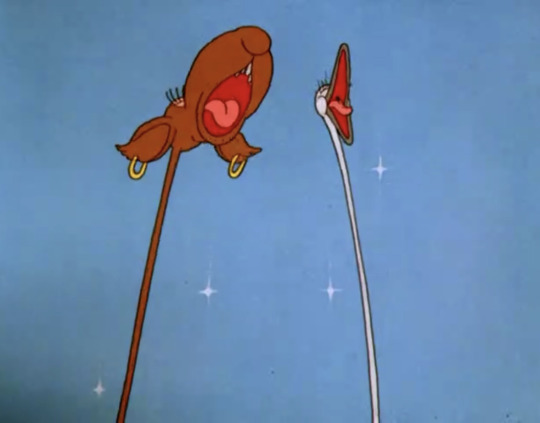
speaking of grace and lily, they’re both highlighted as they fight to out-perform each other, seeing who can sing the highest note. tashlin pulls of a rather intriguing camera move: as the pan settles on the two of them, the background changes. it’s a subtle maneuver, but smart thinking nonetheless--especially since the camera extends into a vertical pan. as both women fight to sing the highest note, their necks extend, both of them scaling high into the night sky, harmonizing on one final shrill note. they both crumple back into the stands, exhausted by their efforts. some fun exaggerated animation for sure--one wonders how much further this would have been pushed had this been tashlin’s second stint at WB rather than his first. his speed often rivaled, if not out-performed, tex avery’s.
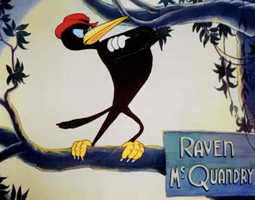
birdie and finchell have a brief interstitial together before making way for a raven caricature of haven macquarrie (raven mcquandry). his sequence is almost jarringly short, but full of fun drawings and poses--the pose of him standing curtly with his arms crossed is awfully reminiscent of izzy ellis’ work under tashlin and later bob clampett in the mid ‘40s. mcquandry asks “do YOU wanna be an actor?”, parotting the name of his real life counterpart’s show so do you want to be an actor? the audience shouts “NO!” in unison, causing mcquandry to do a take and shrug dubiously. though the scene is only a few short seconds, the animation brings forth some much needed vitality.
next is a penguin caricature of joe penner, singing a hilariously out-of-tune rendition of “my green fedora”. the animation is reused from the cartoon of the same name (notice how he doesn’t have penguin feet!), which was also used in toy town hall. not a complaint, but more an observation--this is by far the most humorous performance of the song yet, sung by blanc rather than tommy bond.
another fun scene with some vivacious animation is a sequence featuring a mule caricature of martha raye (dubbed moutha bray), singing a cover of “how could you?”, which has been featured as an underscore in cartoons such as porky’s badtime story and its later remake, tick tock tuckered. raye’s large mouth served as prime material for caricatures, as we see here. the animation is snappy, fun, and vivid--she finishes her song by “swallowing” the camera, an old trick that beckons memories of the harman and ising cartoons of animation past.
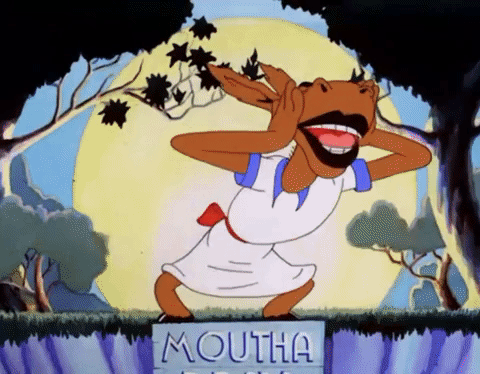
an interesting trend in the ‘30s WB cartoons is the trend of playing with the iris, whether it was the closing iris out or an iris in between transitions. tex avery would consistently play with the final iris out on his cartoons, whereas directors such as friz freleng and bob clampett would use one as a transition between scenes. here, tashlin uses the “swallow the camera” technique as a segue for an iris in, tedd pierce’s falsetto squeaking “hello folksies!” as we’re introduced to a fish caricature of tizzie lish, a character played by bill comstock on al pearce and his gang.
though tizzie has long faded into obscurity (as has the entire community sing radio show), it’s still quite easy to appreciate pierce’s vocals and mannerisms as he portrays the character. it’s always a joy to hear him doing voices for cartoons--he’s never been my favorite writer on the crew, but he was an excellent talent as a voice actor. his squeaky deliveries, matter of fact deliveries “mix them up... are you mixing? my friends say i’m a good mixer. are you? or aren’t you?” as tizzie haphazardly dumps food items and their respective utensils into a bowl and prepares the meal are nothing short of hilarious. the timing is very well executed and can be appreciated regardless of background knowledge.
after humming a pitchy rendition of “the lady in red” while waiting for her concoction to bake in the waffle iron, tizzie removes the homemade waffle and discards it, instructing the audience “now take the ‘wiffle’ out and eat the iron. you must have iron in your system. or should you?” thus concludes tizzie’s act, certainly heightened in hilarity by pierce’s vocals and timing.
for the final act, ben birdie introduces a possum caricature of louella parsons, the host of the radio program hollywood hotel, which served as a way to advertise upcoming movies by featuring guest stars enacting some of the scenes. here, we have caricatures of jack benny (as jack bunny, the first of his many reoccurrences), mary livingstone (canary livingstone), and andy devine (andy bovine).
tedd pierce voices andy bovine, whose voice burlusqued not only in this cartoon, but to a greater extent in friz freleng’s my little buckeroo not even a year later. devine, a western star, was notorious for his scratchy, shrill voice which was rife for comedic opportunity. indeed, this scene here with pierce’s vocals is nothing short of hilarious:

the trio chronicle the prodigal’s return, in which bunny and canary coo over their baby son. out of the bassinet pops incongruously large bovine, who shrieks “HOWDY MAAAA! HI PAAAA!”, the sheer volume of his voice enough to blow both of his parents away and out of the scene. and, with that, the scene ends, red curtains colorized from porky’s romance marking the sequence’s end. short, sweet, to the point, and hilarious.
ending right where the cartoon began, the owl caricature of alexander woollcott bids us farewell, the iris closing in on the bell he rings as he exclaims that all is well.
like so many other cartoons i’ve reviewed, this is one that i slowly warmed up to upon rewatching it and typing out the review for myself. i didn’t entirely dislike the cartoon upon my first watch, but it’s undeniably dated and deserves its title as possibly the most dated cartoon. without further research, some of the jokes and caricatures (if not all of them) are difficult to appreciate. the animation has bursts of energy throughout the short, the highlights being the scenes featuring raven mcquarry and moutha bray, but otherwise remains relatively simple and conservative. tashlin does incorporate a few intriguing camera angles throughout the cartoon, but many other entries of his are far more cinematic.
however, despite all of that, this cartoon is not without its bonuses: art loomer’s backgrounds are stunningly gorgeous and rich, and as someone who loves the lush, painterly backgrounds of the 1930s, this is heaven to me. and, as i mentioned previously, tedd pierce’s scenes are great--the tizzie fish and andy bovine sequences are undeniable comedic highlights.
so, if you’re willing to dedicate time to put in the research for this cartoon, you’ll find it’s quite fascinating! i’m certain this was a much bigger gut-buster in 1937 than it is in 2020, but even then, this is a good cartoon for people such as myself who love to learn more information and seek out facts. as a result, i’d recommend it to people who fall into that category. if you’re just someone who wants a good laugh and a leisurely watch, there are more interesting cartoons that lie ahead. you won’t miss much by skipping it.
with that said, here’s the link!
31 notes
·
View notes
Text
New Post has been published on SONGWRITER NEWS
New Post has been published on https://songwriternews.co.uk/2021/03/what-is-the-passaggio/
What is the Passaggio?

youtube
What is the Passagio? Passaggio is one of the most talked about elements of singing. Some refer to it as the vocal bridge, break, mix or middle.
iSing joins Steve Giles and Chris Johnson from the Naked Vocalist.
Welcome
Why does this vocal phenomenon receive such widespread consideration? Passaggio is Italian for passage or crossing, which may give us slightly more indication of what it is and where it lies: a passage from one place to another. A lot of classical singers use passaggio. When considering the main passaggio, the point of departure is chest voice and we take a vocal journey, sometimes an extremely emotional one, towards head voice. If asked, most people would probably say that singing in the lower part of the voice (referred to as chest voice) is relatively easy. Equally, if we ignore the aesthetics of singing, finding the higher part of the voice (referred to as head voice) can also be a fairly straightforward process for many. However, having the ability to create a smooth transition between these two areas of the voice, both audibly and anatomically, is what often creates the most momentous developmental journey for singers. Hopefully this article can give you a starting point and help you on your momentous journey.
Separating the passaggio in terms of chest and head voice gives us a clear and easy way to understand it. That said, we do think that this can also encourage an unnecessary psychological separation with the voice. Meaning: “I have this really deep low voice, and this really wispy high voice and they need to be joined somehow”. Another way to think about it to dissolve this separation would be to say that every pitch we sing has its own ‘thing’. For those who are thinking this is the most vague article you’ve ever read, let’s put some substance behind the ‘thing’. The ‘thing’ is a number of adjustments made with the cords, resonance chambers (basically, the throat and mouth) which results in settings that are unique for every pitch. Soto voce. From the singer’s lowest note to the highest. In this case, the passaggio gap relate to the places where these adjustments become a little trickier. For the sake of clarity, we’re going to refer to the passaggio as the bridge throughout this section. The bridge is a funny old animal. It’s not necessarily a question of “you bridge, or you don’t”. You can go through the bridge in a variety of ways, some awesome and some not so awesome. But either way, you can still make it through. In other attempts, you might not make it through and the result could be something cat-like. That’s why dealing with the bridge often gets a wide-berth.
There is value knowing what actually happens in the passaggio, so let us open up this can of worms for you. This part can be difficult to digest as the principles of formants, harmonics, and acoustic science gets a bit heavy for some. I will try to simplify it as much as possible, but it is worth doing some research into vocal science and resonance if you want the deeper understanding. Bear with us…There are two resonators that energize the vibrations, or sound waves, that originate from your vocal cords when you sing. These are the throat and the mouth, specifically separated by the tongue. They both add energy to your voice all of the time, but one resonator provides the majority (I repeat, the majority, but not all) of the energy boost depending on the pitch. In the chest voice it’s the throat chamber.
This is because a longer space resonates lower pitches (or frequencies for you nerds) more effectively, and your throat is the longer of the two. For your head voice it’s the mouth chamber that becomes the main resonator. This is because it is the shorter of the two spaces and can resonate the higher pitches more effectively. That’s vocal/acoustic science in a nutshell (cue the scientists wincing). As you ascend in pitch there is a gradual handover from one resonator to another, of which the main tipping point is at the first bridge. At this point the throat becomes unable to effectively boost the sound waves because it is too long, and so the perfect resolution is to hand it over to the mouth.
Read the full article: http://www.isingmag.com/passaggio/
ABOUT US
Dedicated to singers and singing we produce articles, education and a podcast for singers.
Check out the Tribe membership for access to webinars, articles, interviews, courses, discounts and more: http://bit.ly/TribeMembership
Free membership ensures you never miss out on our regular articles.
Come hang with the tribe!
Facebook: https://www.facebook.com/isingmag Instagram: https://www.instagram.com/isingmag Twitter: https://twitter.com/isingmag Website: http://www.isingmag.com Look for the iSingmag Podcast on iTunes | Spotify | Stitcher source


#bridge vocal gap#clean vocal bridge#Coaching#falsetto#female vocal bridges#Guitat tuition#learning#male vocal bridges#music#Music tuition#Online learning#passaggio#passaggio exercises#passaggio tenor#passaggio voice#Piano tuition#singing tips#songwriter news#songwriternews#songwriting#songwriting courses#songwriting tuition#soto voce#step#step singing#Tuition#Violin tuition#vocal bridge#vocal bridge exercises#vocal bridges
0 notes
Text
Her Platformdan Bir Öneri #1
Her Platformdan Bir Öneri #1
Netflix The Queen’s Gambit Satranç sevenler buraya gelsin sevmeyenler ise diziden sonra kendine bir satranç takımı almaya gidecek Beth Harmon adlı öksüz satranç dehasının küçük yaştan itibaren yaşadıklarını ve dünyanın en iyi satranç oyuncusu olma yolculuğunda madde bağımlılığına karşı verdiği mücadele anlatılıyor. Prime Video Hanna 2011 yapımı aynı isimli filmin uyarlaması olan Hanna,…

View On WordPress
0 notes
Text
Weds 30 December 1818
7 10/60
11 1/4
Let[ter] fr[om] Miss Marsh(Micklegate York) Staunton Stainforth’s d[au]g[h]t[e]r 2 d[ay]s Rich[ard]d S_ Esq[ui]re Hutton n[ea]r Malton Mr Gage ver[y] ill and Mrs Waterston n[o]t likely to continue long. My a[un]t and I were at the new court-room ab[ou]t 11. The examinat[io]n beg[a]n soon aft[er] 7 or 8 pianos and all play[e]d on at once. Am[on]g the players Mrs Wilcock, Miss Waterhouse sen[io]r one of h[e]r nieces, Miss Dawson (Stansfield’s d[au]ght[e]r Catherine) Miss Maria Brown_ 1 of Dr Gervase Alenaud’s d[au]ght[e]r, a Miss Robinson fr[om] Huddersfield, a Miss Graeme of Exley.Mrs Susan Staveley a d[au]ght[e]r of the clerk of the old ch[ur]ch and c [so forth] and c[so forth]. Messrs Stopford and Holdsw[or]th being s[ai]d to ha[ve] 23 pup[il]s. Mr Jos[e]ph Bottomley a mus[ic] mast[er] in the town was pres[en]t all the time ask[in]g the pup[il]s dur[in]g the examinat[io]n in the principles of mus[ic] and harmonics man[y] quest[ion]s all of w[hi]ch they seem[e]d t ans[wer] right.Mr B_[Bottomley] I underst[an]d h[a]s writ[ten] someth[ing] ag[ain]st Logier’s syst[em] in conseq[uence] of w[hi]ch Mr L [Logier] sent for him. What the pup[il]s play[e]d was an easy air of L [Logiers] w[i]th diff[eren]t variat[ion]s for the differ[en]t perform[er]s the mo[st] skilful of w[hi]ch cov[ere]d the defects (if there were any) and fill[e]d up the harmony of the less skilful pup[il]s (some of them child[re]n of 6 weeks stand[in]g not being likely to do m[u]ch. Mrs Wilcock and Miss Waterhouse sen[io]r were n[o]t exam[ine]d like the rest in harmon[i]cs, The examinat[io]n ov[er] Miss Logier accomp[anie]d by h[e]r fath[er] on anoth[er] piano play[e]d a concerto (vid. [see] Thurs[day] 31) brilliantly well. Mr Ralph told my a[un]t she was account[e]d 1 of the best play[e]rs in [Sheffield]. She is a pretty look[in]g girl w[i]th a ver[y] good counten[an]ce rath[er] fat, rath[er] bel[ow] the mid[dle] size and ver[y] neat in a grey spotted poplin pelisse.H[e]r fath[er] [also] ver[y] good count[enan]ce. Seem[e]d m[u]ch pleas[e]d w[i]th the prog[ress] made and ga[ve] the teachers and taught gr[ea]t cred[i]t ab[ou]t 1/2 the room appropriate[e]d to the audience. Rath[er] crowd[e]d –there must ha[ve] been consid[erabl]y ab[ov]e 100 tick[e]ts gratis.
The sho[w] was ov[er] abou]t 1 1/2 . J[u]st bet[ween] Emma Saltmarsh and Miss Prescott , my [un]t next Miss P [Prescott] being fort[unate] in get[in]g setas as we were late. Prom[ise]d Emma to go and sit an h[ou]r w[i]th h[e]r aft[er] sh[e]d h[a]d a walk.W[e]nt w[i]th my a[un]t to N[orth]gate, st[oo]d there 10 min[ute]s then walk[e]d to Pye Nest to inq[uire] aft[er] Mrs E_ [Edwards]. F[ou]nd Mr H E [Edwards] at din[ner] and took a lit[tle] w[i]th him. He shew[e]d me the sinkfence and oth[er] lit[tle] improve[men]ts he has n[ear]ly complet[e]d in front and on the gard[en] side [of] the house, Mrs Edwards and the child doing exceed[in]g well.
G[o]t to the Saltmarshes’ at 3 1/4 f[ou]nd them at dessert, sat w[i]th E.S. [Emma Saltmarsh] ver[y]pleas[an]t till 5 and g[o]t ho[me] at 5 3/4 by our clock (20 min[ute]s too soon) . My unc[le] din[ed]d at Hipperholme if meet[in]g of the sch[oo]l and h[a]d not ret[ur]n [till]. My a[un]t and I sp[en]t the ev[ening] in conversat[io]n fam[il]y affairs and coach adventures in beset by the bad women setting off in the mail to Langton from the black swan
Howev[er] manag[e]d to cop[y] int[o] the bookWed[nesday] 23[r]d inst. Ver[y] fine frosty day B[arometer] at 34° and F [Fahrenheit] 1/4°ab[ov]e fair at 9p.m.
WYAS reference number : SH:7/ML/E/2/0094
0 notes